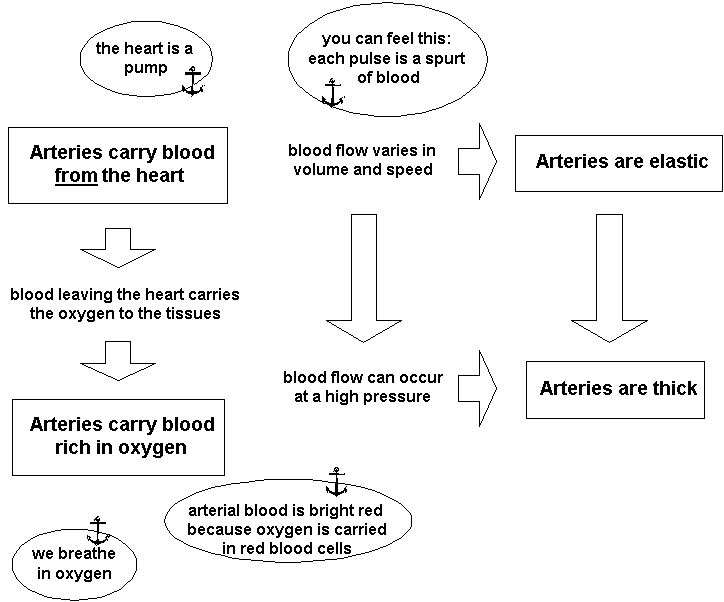Questions — especially why questions — help us make connections to existing anchor points — facts we know well. But some questions are better than others.
To decide whether a question is effective, ask:
- does it make the information more meaningful?
- does it make the information more comprehensible?
- does it increase the number of meaningful connections?
Consider our facts about blood:
- arteries are thick and elastic and carry blood that is rich in oxygen from the heart.
- veins are thinner, less elastic, and carry blood rich in carbon dioxide back to the heart.
We could, as is often advised, simply turn these into why questions. And we can answer these on the basis of the connections we’ve already made:
Why are arteries elastic?
Because they need to accommodate changes in pressure
Why are arteries thick?
Because they need to accommodate high pressure
Why do arteries carry blood away from the heart?
Because blood coming from the heart comes out at high pressure and in spurts of variable pressure
Why do arteries carry blood that is rich in oxygen?
Because the blood coming from the heart is rich in oxygen
Why are veins less elastic?
Because the blood flows continuously and evenly
Why are veins less thick?
Because the blood flows at a lower pressure
Why do veins carry blood to the heart?
Because blood going to the heart flows continuously and evenly
Why do veins carry blood that is rich in CO2?
Because the blood going to the heart is rich in CO2
What’s missing? Connections between these facts. The facts have become more meaningful, but to be really understood you need to make the connections between the facts explicit.
Look again at our original questions. See how they relate the facts to each other? They don’t ask: why are arteries elastic? They ask: Why do arteries need to be more elastic than veins? They don’t ask: why do arteries carry blood that is rich in oxygen? They ask: why do vessels carrying blood from the heart need to be rich in oxygen?
By answering these questions, we have built up an understanding of the facts that ties them together in a multi-connected cluster:

For simplicity, I’ve just focused on the arteries. See how the four facts about arteries are connected together. Meaningfully connected. In a perfect world we’d be able to close the circle with a direct connection between the facts “Arteries carry blood rich in oxygen” and “Arteries are thick”, but as far as I know, the only connection between them is indirect, through the fact that “Arteries carry blood from the heart”.
So … the world isn’t perfect, and information doesn’t come in neatly wrapped bundles where every fact connects directly to every other fact. But the more connections you can make between related facts — the stronger a cluster you can make — the more deeply you will understand the information, and the more accessible it will be. That is, you will remember it more easily and for longer.
If it’s well enough connected
If it’s connected to strong anchor points
You will simply 'know' it.
You’re never going to forget that you breathe in oxygen and that your heart pumps out blood. These are strong anchor points. If the facts about arteries are strongly connected to these anchor points, you will never forget them either.
Asking questions is one of the best ways of making connections,
but
Bad questions can be worse than no questions at all.
Rote questions that direct your attention to unimportant details are better not asked.
Effective questions prepare you to pay attention to the important details in the text.
The best questions not only direct your attention appropriately, but also require you to integrate the details in the text. Ask yourself:
- Is this helping me to select the important information?
- Is it helping me make connections?
When the subject is new to you
When you don’t have enough prior knowledge about a subject to ask effective questions, you are better off forming connections using mnemonics — either through verbal elaboration, as in our sentence about “Art (ery) being thick around the middle so he wore trousers with an elastic waistband” or by creating interactive images.
However, mnemonics such as these — while perfectly effective — are only good for rote learning. Sometimes that’s all you want, of course. But if you’re going to be learning more information that relates to these facts, then you’re making a rod for your own back.
When you learn something by rote, it never gets easier. When you learn by building connections, every new fact is acquired more easily. And it’s progressive. An expert on a subject can hear a new fact in her area of expertise, and it’s there. Remembered. Without effort. Because she’s an expert. And what makes her an expert? Simply the fact that she’s built up a network of information that is so tightly connected, and that has so many strong anchor points, that the information is always retrievable.
Why questions, like any questions, are only effective to the extent that they direct attention to appropriate information.
Research confirms that it is better to search for consistent relations than inconsistent ones. In many cases your background knowledge may include information that is consistent with the new information, and information that is inconsistent.
By asking “Why is this true?” you focus on the consistent information.
- Woloshyn, V.E., Willoughby, T., Wood, E., & Pressley, M. 1990. Elaborative interrogation facilitates adult learning of factual paragraphs. Journal of Educational Psychology, 82, 513-524.
- Pressley, M. & El-Dinary, P.B. 1992. Memory strategy instruction that promotes good information processing. In D. Herrmann, H. Weingartner, A. Searleman & C. McEvoy (eds.) Memory Improvement: Implications for Memory Theory. New York: Springer-Verlag.